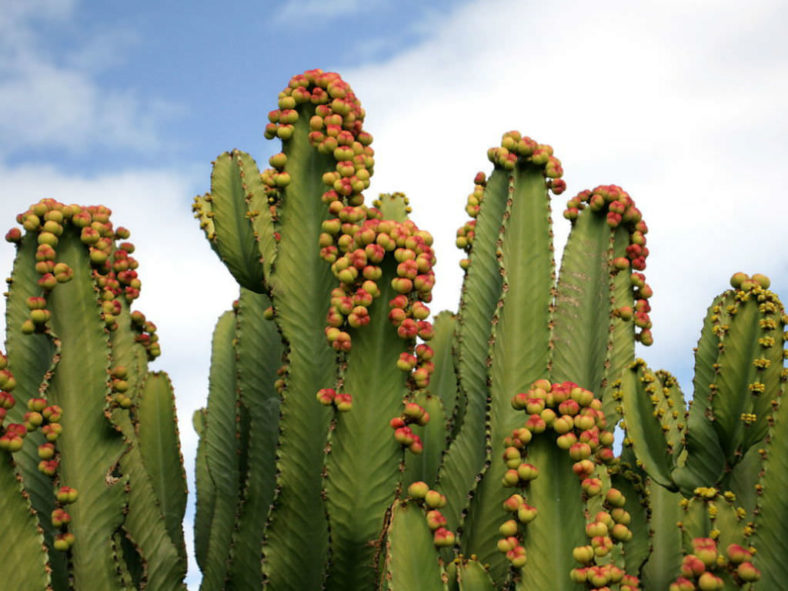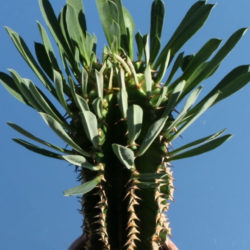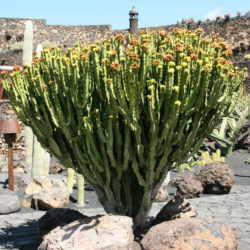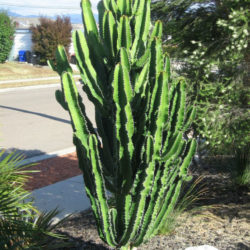Scientific Name
Euphorbia abyssinica J.F.Gmel.
Common Name(s)
Candelabra Spurge, Desert Candle
Synonym(s)
Euphorbia acrurensis, Euphorbia controversa, Euphorbia disclusa, Euphorbia erythraeae, Euphorbia neglecta, Euphorbia obovalifolia
Scientific Classification
Family: Euphorbiaceae
Subfamily: Euphorbioideae
Tribe: Euphorbieae
Subtribe: Euphorbiinae
Genus: Euphorbia
Description
Euphorbia abyssinica is a large tree-like succulent with a green trunk that becomes woody with age and supports many ascending green branches, forming a dense, broadly obconical crown. It can grow up to 33 feet (10 m) tall. The branches are up to 4.8 inches (12 cm) thick, have three to eight, usually 4 deep, often slightly twisted ribs, and branch at intervals. The leaves are green, oblanceolate, up to 2 inches (5 cm) long, form on young growth at the end of the branches, and soon fall. The beach ribs are lined with triangular spine shields, bearing pairs of stout spines that can reach up to 0.4 inches (1 cm) in length.
The plant blooms from winter to summer. The male flowers are reduced to a single stamen, while the female flowers consist of a stalked pistil with branched stigmas. The fruits are three-locular capsules.
Origin
Euphorbia abyssinica is native to Sudan, Eritrea, Djibouti, Ethiopia, and Somalia. It grows on arid hillsides, montane woodland, and scrubby savannahs.

Hardiness
USDA hardiness zone 9b to 11b: from 25 °F (−3.9 °C) to 50 °F (+10 °C).
How to Grow and Care
Euphorbias are very easy to care for. They require a little pampering to become established, but once they are, they are self-sufficient. More die from too much care and watering than from neglect. Euphorbias need well-draining soil and lots of sunlight. They are not particular about soil pH but cannot tolerate wet soil. Unlike most succulents, Euphorbia does not handle long periods of drought well. It may need weekly watering during the summer. Water whenever the soil is dry several inches below the surface. Water deeply, but don't let them sit in wet soil, which can cause root rot. Add some organic matter or fertilizer to the planting hole. Feed with a half-strength fertilizer monthly if you are growing them in containers or your soil is poor.
Euphorbia can be grown from seed, but they can be difficult to germinate (or even find). It is usually propagated by cuttings. This can be tricky because of the exuding sap. Rooting hormone is recommended with Euphorbias. They tend to grow problem-free, but there are a few pests and diseases to be alert for.
See more at How to Grow and Care for Euphorbia.
Links
- Back to genus Euphorbia
- Succupedia: Browse succulents by Scientific Name, Common Name, Genus, Family, USDA Hardiness Zone, Origin, or cacti by Genus
Photo Gallery
Click on a photo to see a larger version.


